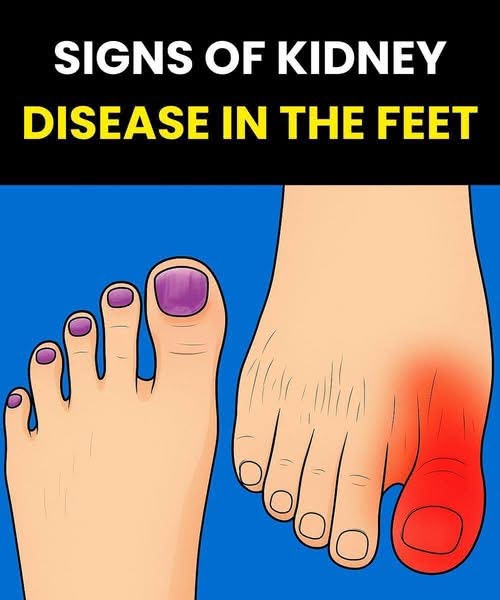Your kidneys do much more than just filter waste — they help regulate blood pressure, balance electrolytes, support bone health, and control fluid levels. But when kidney function starts to decline, your feet might be among the first places to show warning signs.
Here are 9 symptoms to watch for, especially if they’re persistent or unexplained:
1. Swelling in the Feet (Edema)
If your kidneys can’t remove excess sodium and fluid efficiently, fluid buildup can occur — especially in the ankles, feet, and legs.
Look out for:
Puffy feet or ankles
Tighter shoes or sock marks
Skin that dents when pressed (called pitting edema)
2. Numbness, Tingling, or Twitching
When waste products like urea accumulate in the bloodstream, they can damage nerves — especially in the extremities.
This may cause:
Tingling or burning sensations
Reduced sensation (risking unnoticed injuries)
Muscle twitches or cramps
3. Foot Pain or Aches
Disrupted calcium and phosphorus balance can affect bone and joint health, causing:
Aching feet
Pain in the toes or heels
Gout attacks (often starting with sudden, intense pain in the big toe)
4. Skin Color Changes
Kidney dysfunction may reduce blood flow and oxygen delivery, affecting skin tone. You may notice:
Pale or bluish feet (poor circulation)
Reddish or darker skin (venous congestion or hyperpigmentation)
5. Dry, Itchy Skin
High levels of phosphorus or other waste products in the blood can lead to:
Persistent dryness
Flaky skin on feet and ankles
Intense itchiness that worsens at night
6. Slow-Healing Wounds or Ulcers
Poor circulation and nerve damage (neuropathy) increase the risk of:
Foot injuries going unnoticed
Wounds taking longer to heal
Infections or diabetic ulcers (which can lead to serious complications)
7. Restless Legs Syndrome (RLS)
This uncomfortable condition is common in chronic kidney disease (CKD), often due to low iron or reduced erythropoietin (EPO).
You may experience:
Burning or tingling sensations
An uncontrollable urge to move your legs (especially at night)
Difficulty sleeping due to discomfort
8. Nail Changes
Your toenails may reflect underlying health changes. Signs to watch for:
White bands or lines across the nails
Unusual discoloration or thickness
Brittleness or abnormal nail growth
9. Muscle Cramps & Fatigue
Imbalances in electrolytes like calcium, magnesium, or potassium can lead to:
Painful muscle cramps (often in the feet or calves)
Ongoing fatigue or weakness
Shortness of breath (linked to anemia from reduced kidney hormone production)
Why These Signs Matter
Kidney disease often develops silently — symptoms may not appear until significant damage has occurred.
Recognizing early signs, especially subtle ones like changes in your feet, can:
Help slow the progression of kidney damage
Prevent complications
Delay or avoid dialysis or transplantation
When to See a Doctor
If you notice persistent or unusual foot symptoms, especially alongside:
Changes in urination
Unexplained fatigue
High blood pressure
…consult a healthcare provider promptly. Simple blood and urine tests can detect kidney issues early — and early action can make a huge difference.
Stay proactive.
Your feet might be trying to tell you something. Listening now could protect your kidneys — and your overall health — in the long run.

Leave a Reply